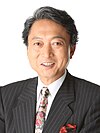Democratic Party (Japan, 1996)
Democratic Party of Japan 民主党 Minshutō | |
|---|---|
 | |
| President | Naoto Kan |
| Chief Secretary | Yukio Hatoyama |
| Founders | Naoto Kan Yukio Hatoyama |
| Founded | 29 September 1996 |
| Dissolved | 27 April 1998 |
| Split from | New Party Sakigake Social Democratic Party of Japan |
| Merged into | Democratic Party of Japan |
| Ideology | Liberalism |
| Political position | Centre |
The Democratic Party of Japan (民主党, Minshutō) was a centrist[1][2][3] political party in Japan, and one of the forerunners to the Democratic Party of Japan formed in 1998. Its two leading members, Yukio Hatoyama and Naoto Kan, subsequently and sequentially became Prime Ministers at the end of the first decade of the 21st century.
History[edit]
The party was founded on 29 September 1996 by sitting members of the Diet,[4] and was composed mostly of former Sakigake and Japan Socialist Party politicians who did not support an alliance with the ruling Liberal Democratic Party.[5] Its initial leaders were Yukio Hatoyama and Naoto Kan, formerly members of Sakigake.[6] At its formation, it had 39 parliamentarians.[6]
The party won 52 seats in the 1996 general election, becoming the second-largest opposition party after the New Frontier Party.[7]
In April 1998, the party was augmented by former members of the New Frontier Party, which had collapsed in December 1997, increasing it to 90 seats.[6] It then merged with the Good Governance Party (Minseitō), New Fraternity Party and Democratic Reform Party to create Democratic Party of Japan.[6]
Presidents of DPJ[edit]
| No. | Name | Photo | Took office | Left office | ||||
|---|---|---|---|---|---|---|---|---|
| Preceding party: New Party Sakigake & Social Democratic Party | ||||||||
| 1 | Co-leadership
|
26 September 1996 | 16 September 1997 | |||||
| 2 | Naoto Kan |  |
16 September 1997 | 27 April 1998 | ||||
| Successor party: Democratic Party (1998) | ||||||||
Election results[edit]
House of Representatives[edit]
| Election | Leader | Constituency | Party list | Seats | Position | Status | ||||
|---|---|---|---|---|---|---|---|---|---|---|
| Votes | % | Seats | Votes | % | Seats | |||||
| 1996 | Naoto Kan | 6,001,666 | 10.62 | 17 / 300
|
8,949,190 | 16.10 | 35 / 200
|
52 / 500
|
3rd | Opposition |
References[edit]
- ^ Eiji Takemae (2003). Allied Occupation of Japan. Continuum. p. 540. ISBN 978-0-8264-1521-9.
- ^ Glenn D. Hook; Julie Gilson; Christopher W. Hughes; Hugo Dobson (2013). Japan's International Relations: Politics, Economics and Security. Routledge. p. 58. ISBN 978-1-134-32806-2.
- ^ "Japan's fractured opposition unites as Suga set to succeed Shinzo Abe as prime minister". CNBC.com. CNBC. Reuters. 8 September 2020. Retrieved 22 March 2021.
The centrist Democratic Party of Japan (DPJ), founded in 1996, has long struggled with internal dissent.
- ^ Patrick Koellner (2011). "The Democratic Party of Japan: Development, organization, and programmatic profile". In Alisa Gaunder (ed.). Routledge Handbook of Japanese Politics. Taylor & Francis. p. 25. ISBN 978-1-136-81838-7.
- ^ Gerald L. Curtis (2013). The Logic of Japanese Politics: Leaders, Institutions, and the Limits of Change. Columbia University Press. p. 193. ISBN 978-0-231-50254-2.
- ^ a b c d James Arthur Ainscow Stockwin (2003). Dictionary of the Modern Politics of Japan. Routledge. p. 42. ISBN 978-1-136-89488-6.
- ^ Robert W. Aspinall (2001). Teachers' Unions and the Politics of Education in Japan. SUNY Press. p. 174. ISBN 978-0-7914-5050-5.

